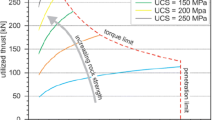Abstract
Tool wear and tool life are very important issues for soft ground tunnel boring machines (TBMs) as they are directly related to the time and cost of tunneling. These issues may even become more important in planning costly interventions. In this regard, there are a few methods available to assess the tool life; however, the need for a thorough discussion and the development of new models is still highly demanded by the industry. This paper presents a summary of different methods for soft ground tool life, and tool wear evaluation. A comparative study is performed to indicate the predictability of available tool life evaluation methods based on the collected data from 23 soft ground TBM projects from around the world. Based on this database, new formulas are developed to evaluate tool life and tool wear for both primary and secondary cutting tools. The data analysis is conducted with single and multiple regression methods. The results show the equivalent quartz content and the standard penetration test are among the major influencing parameters for the evaluation of tool life of the primary cutting tools. In this regard, an estimation chart is generated for the quick evaluation of tool life for both earth pressure balance and slurry TBMs. The outcomes of this paper can be very useful in both the planning and construction stages of a TBM tunneling project where the intervention interval length and tool life/wear become critical decision-making factors for scheduling and cost evaluation and for reducing the risks of unwanted severe damage on the cutters.



















Similar content being viewed by others
References
AFNOR (1990) Experimental Standard P18-579: Aggregates - Abrasiveness and grindability test, AFNOR Association française de normalization, Paris, 6 S
ASTM G75-15 (2015) Standard Test Method for Determination of Slurry Abrasivity (Miller Number) and Slurry Abrasion Response of Materials (SAR Number), ASTM International, West Conshohocken, PA, www.astm.org
ASTM G65-16 (2016) Standard Test Method for Measuring Abrasion Using the Dry Sand/Rubber Wheel Apparatus, ASTM International, West Conshohocken, PA, www.astm.org
Barzegari G, Uromeihy A, Zhao J (2013) A newly developed soil abrasion testing method for tunneling using shield machines. J Eng Geol Hydrogeol 46(1):63–74
Deketh HJR (1995) The wear of rock cutting tools. Laboratory experiments on the abrasivity of rock. Balkema, Rotterdam
Drucker P (2013) About the abrasiveness of loose rock and tool wear, Dissertation, TU Wien, 158 p
Farrokh E, Kim DY (2018) A discussion on hard rock TBM cutter wear and cutterhead intervention interval length evaluation. Tunn Undergr Sp Technol 81:336–357
Fowler DW, Allen JJ, Lange A, Range P (2006) The prediction of coarse aggregate performance by Micro-Deval and other aggregate tests. The University of Texas at Austin. International Center for Aggregate Research ICAR Report
Frank G, Shinouda MM, Hauser G (2010) Tunneling on Brightwater west. Tunneling, Proceedings of North American
Gharahbagh EA (2013) Development of a soil abrasion test and analysis of impact of soil properties on tool wear for soft-ground mechanized tunneling, PhD dissertation, The Pennsylvania State University
Harrison DJ, Bloodworth AJ (1994) Industrial minerals laboratory manual construction materials, British Geological Survey, Technical Report WG/94/12
Jakobsen PD (2014) Estimation of soft ground tool life in TBM tunneling, PhD dissertation, Norwegian University of Science and Technology
Koppl F (2014) Cutting tool wear and wear prognosis for hydroshield TBM in soft ground. PhD Dissertation. Technische Universität München
Koppl F, Thuro K (2013) Cutting tool wear and management of wear related risks for Mix-Shield TBM in soft ground. Proceedings of the 18th International Conference on Soil Mechanics and Geotechnical Engineering, Paris, 1739–1742
Lislerud A (1997) Principles of mechanical excavation, Tamrock Corp, POSIVA report code 97-12, Finland, p 251
Nakamura T (2011) Wear in soil tunneling. P. D. Jakobsen cited in Jakobsen PD (2014) Estimation of soft ground tool life in TBM tunneling, PhD dissertation, Norwegian University of Science and Technology
Nilsen B, Dahl F, Holzhäuser J, Raleigh P (2006) Abrasivity of soils in TBM tunneling. Tunnels and Tunneling International, pp 36–38
Nilsen B, Dahl F, Holzhäuser J, Raleigh P (2007) New test methodology for estimating the abrasiveness of soils for TBM tunneling. Proceeding of RETC conference, pp 104–116
Paez CVG (2014) Rendimiento, desgaste y abrasividad en excavación mecanizada de túneles en terrenos heterogéneos, PhD thesis, Universitat Politècnica de Catalunya (UPC), Departament d'Enginyeria del Terreny, Cartogràfica i Geofísica, p 500. http://hdl.handle.net/2117/95510
Peila D, Picchio A, Chieregato A, Barbero M, Dal Negro E, Boscaro A (2012) Test procedure for assessing the influence of soil conditioning for EPB tunneling on the tool wear. World Tunneling Congress, Bangkok
Rosiwal A (1916) Neuere Ergebnisse der Härte Bestimmung von Mineralien und Gesteinen. Ein absolutes Maß für die Härte Spröder Körper. Verhandlg d kk geol R-A Wien, pp 117–147
Thuro K, Kaesling H (2009a) Classification of the abrasiveness of soil and rock. Geomech Tunn 2:179–188
Thuro K, Kaesling H (2009b) Classification of the abrasiveness of loose and solid rock–minimization of the background risk. Proceedings of the 17th session Engineering Geology with Forum for Young Engineering Geologists, pp 137–142
Thuro K, Plinninger RJ (2003) Hard rock tunnel boring, cutting, drilling and blasting: rock parameters for excavatability, ISRM 2003–Technology roadmap for rock mechanics. South African, Johannesburg, pp 1227–1234
Ugur I, Demirdag S, Yavuz H (2010) Effect of rock properties on the Los Angeles abrasion and impact test characteristics of the aggregates. Mater Charact 61(1):90–96
Wendl K (2012) Engineering geological excavation documentation and analysis of slurry shield tunneling. Munich geoscientific papers, Series B, engineering geology, hydrogeology. Geothermal 18:148 S Munich
Yi P, Jianqin L, Wei G, Ruiying P (2011) The research of cutting tool layout method of earth pressure balanced shield, College of Mechanical Engineering, TianJin University, TianJin. J Mech Eng 47(15):161–168
Author information
Authors and Affiliations
Corresponding author
Rights and permissions
About this article
Cite this article
Farrokh, E. Primary and secondary tools’ life evaluation for soft ground TBMs. Bull Eng Geol Environ 80, 4909–4927 (2021). https://doi.org/10.1007/s10064-021-02223-4
Received:
Accepted:
Published:
Issue Date:
DOI: https://doi.org/10.1007/s10064-021-02223-4




